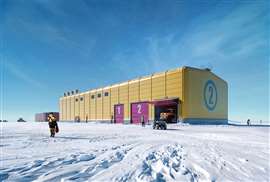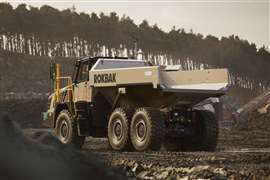Read this article in Français Deutsch Italiano Português Español
Bouygues to help modernise Australia’s Davis Antarctic Station
25 September 2025
Bouygues Construction Australia has been chosen by the Australian government as part of an alliance to modernise the Davis research station in Antarctica.
 Davis Station is Australia’s southernmost Antarctic station and is located in one of the most extreme environments on the planet. Photo credit: Hugh Broughton Architects
Davis Station is Australia’s southernmost Antarctic station and is located in one of the most extreme environments on the planet. Photo credit: Hugh Broughton Architects
The project – for which Bouygues Construction has a share of AU$150.5 million (US$99 million) will start at the end of 2026 with delivery scheduled for 2032.
The modernisation of the Davis Research Station, built in the 1950s, will enable Australia to secure the expeditions of its scientific base, while reducing its environmental footprint.
The project is to be undertaken by the Australian Antarctic Division (AAD) with an alliance including Bouygues Construction Australia, Stantec and Mott McDonald.
Work on the Davis Station will include: Replacement of water production systems; construction of a new main powerhouse; development of a new vehicle workshop; refurbishment of the existing trades workshop and decommissioning and removal of legacy infrastructure.
Davis Station is Australia’s southernmost Antarctic station and is located in one of the most extreme environments on the planet, on the Ingrid Christensen Coast of Princess Elisabeth Land.
There are significant logistical challenges working in the harsh Antarctic environment. Davis Station experiences very strong winds, with gusts of over 200 km/h and the average winter temperature sits at around -21°C, sometimes plummeting to -42°C.
For this reason, the construction season is limited to the warmer months of October through to February, with no extensions possible. It is the only Australian station without a natural freshwater source, relying on reverse osmosis and shipped water, which limits supply during winter and caps population numbers.
The project has a focus on employing local specialists based in Tasmania who will be selected between the Alliance members with qualified workers travelling to Antarctica each season.
The entire project will be subject to stringent environmental approvals.
“This project represents an extraordinary technical challenge for our teams, who will bring all their engineering expertise and innovative spirit to bear. Building for life also means contributing to scientific research in the polar regions to better understand climate change in our world,” said Pascal Minault, Chair and CEO, Bouygues Construction.
STAY CONNECTED


Receive the information you need when you need it through our world-leading magazines, newsletters and daily briefings.
CONNECT WITH THE TEAM











